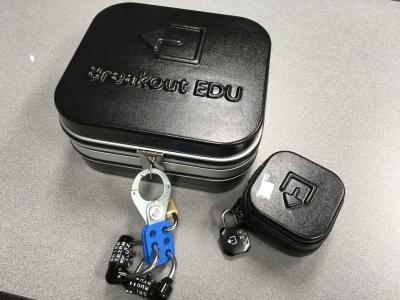Like the increasingly popular "escape rooms" — in which players solve a series of puzzles to break out of a room — Breakouts use a compelling story, time limit, and series of puzzles to create an interactive game. But instead of breaking out of a locked room, students must work together to break into a tightly locked box before the timer runs out. Puzzles lead to the combinations for the different types of locks, and many games also include a digital element.
Why should I use Breakouts?
There are many benefits to using Breakouts. These include:
- Adaptability. Breakout kits consist of reprogrammable locks, meaning that each kit can be used for hundreds of different games.
- Curriculum connections. Games can be created for specific content areas and used to reinforce skills and concepts being taught in everyday classroom instruction. They can be used to introduce a new unit or to wrap up and test comprehension at the end of a unit. They can even be used as team-building exercises for faculty and staff.
- Student-centered learning. Breakout games are completely student-centered and transfer the ownership of learning and applying that learning onto the student rather than the teacher. Teachers only act as facilitators — the rest is up to the students.
- Suitable for all age groups. Games have been created for elementary students all the way to adults, and more are being added every day.
- Develops the 4 Cs. Each game requires students to use collaboration, communication, critical thinking and creativity in order to succeed.
- Teaches the value of failure in a safe way. Students will not always "break out," and that's ok. If the combination they tried didn't work, they see that it is OK to try again until they get it right. Using reflection questions at the end of the game also helps students pinpoint where they could improve and use those lessons the next time they play.
- It's fun. Let's face it — the games are just fun to play.
- Image

This group of middle schoolers *almost* broke the code.
Breakouts in my library
At my school, we use Breakouts in three ways: in the classroom, as library programs and this summer, as the theme for a weeklong day camp.
- In the classroom: I have a total of four Breakout kits that I can lend to teachers to use in their classrooms. This has started off slow, but it's picking up traction as teachers see how much their students enjoy it. If I see a game that matches what teachers are working on in class, I'll approach them and offer to help them pull it off. I've also held example games for teachers so they can see how it works.
- In the library: Once a week, I have Breakout day in the library for my middles schoolers. I shorten games to last only 15 minutes instead of the usual 45, and students come for half of their lunch period to play. I change the game every month so that plenty of students have the opportunity to try each game. When they successfully "break out," they get a sticker, which also helps to market the program. This would also be a great after-school activity, and next fall, I'm planning to create a library orientation game for my new sixth graders.
- Summer camp: This summer, we will have our first ever Breakout camp as part of the school's summer camp offerings. Along with playing plenty of Breakout games, campers will also work in small groups to create their own games.
Image

Getting Started
- Get a kit. You can purchase a kit with all the necessary pieces from Breakout EDU, but you can also create your own by purchasing individual locks and boxes from Amazon or other stores. Just make sure that all your locks are reprogrammable.
- Or try a digital game first. There are a number of digital-only Breakout games that follow all the same principles of Breakout, but don't require spending any money. These can be a great way to introduce students to the concepts and game flow.
- Pick a game. The Breakout EDU site has over 300 games that are ready-made for you to play, with more being added everyday, and each has a set-up video to walk you through the game's logistics. Games are password-protected so students can't just Google the answers, but it's free to register for access. I'd also recommend starting with a game that is easier than you think you need to get students used to the process.
- Just play. The best way to learn is just to do it.
Resources
- Breakout EDU
- Breakout EDU Facebook Group — a place where facilitators from all backgrounds and levels share advice and resources
- Breakout EDU Brings “Escape Room” Strategy to the Classroom | SLJ Review



